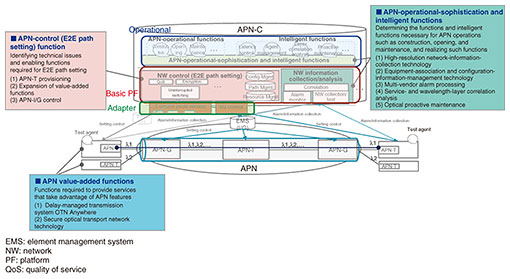 |
|||||||||||||||||||
|
|
|||||||||||||||||||
|
Feature Articles: Efforts toward the Early Deployment of IOWN Vol. 22, No. 1, pp. 56–63, Jan. 2024. https://doi.org/10.53829/ntr202401fa7 APN-controller Technology for IOWN Service Provision and ExpansionAbstractThe All-Photonics Network (APN), which is the basis of the Innovative Optical and Wireless Network (IOWN), has the characteristics of high speed, large capacity, low latency, and low power consumption compared with conventional networks. We aim to provide services that take full advantage of these characteristics as early as possible and expand their use. To operate high-quality services with these capabilities, the role of controllers has become more important than in conventional networks. In this article, we explain the APN-control function and APN-information-collection/analysis function, which are the main pillars of the APN-controller technology, as well as the value-added functions to implement the IOWN service. Keywords: IOWN, APN controller, information collection and analysis technology 1. IntroductionTo achieve high speed, large capacity, low latency, and low power consumption in the All-Photonics Network (APN), which is the basis of the Innovative Optical and Wireless Network (IOWN), and provide open interfaces to offer a wide variety of services and quickly and flexibly handle various network components, the role of the APN controller (APN-C), which manages and operates the APN, has become important. Therefore, we are developing functions of the APN-C to expand the use of services that use the APN. We are also actively researching and developing value-added functions such as services that make maximum use of low latency, which is one of IOWN’s characteristics, and security functions that will be essential in the future. 2. APN-C overviewThe main functions of the APN-C are the APN-control (end-to-end (E2E) path setting) function, which is the basis for providing E2E services in multi-vendor, multi-carrier networks, and APN-operational-sophistication and intelligent functions that control the opening, maintenance, and information gathering functions necessary for business execution. Regarding the APN-control function, we aim to achieve a complete E2E path setting, including final relay transmission equipment (APN-I*1/G*2) and terminal (APN-T)*3 [1] control. It provides terminal-control functions that enable control of a variety of APN-Ts to become endpoints, as well as E2E path design and settings at APN-I/Gs. To enable E2E operation in multi-vendor and multi-carrier networks, the APN-operational-sophistication and intelligent functions are necessary for APN maintenance operations such as information collection and alarm monitoring, and visualization analysis across optical and service layers. They also include operational and intelligent functions such as visualization analysis that spans optical and service layers and proactive maintenance that uses performance monitoring (PM) information (Fig. 1).
3. APN-C configurationThe basic policy for developing the APN-C’s functions is to start small in line with the development of the APN and be able to provide functional parts as needed. The basic configuration is a three-layer structure consisting of the basic platform (PF) (i.e., a network management system (NMS)), adapter (equipment control), and operational intelligence. By developing the operational-intelligent and adapter component, it is possible to respond flexibly and quickly to new equipment and the addition of equipment functions. The APN, to which the initial APN-C is applied, has a single vendor’s APN-I/Gs. Regarding an APN-T, we will enable wavelength connectivity for each vendor’s equipment. 4. Details of APN-control function (E2E path setting)For the E2E path setting with APN-Ts as both endpoints, including those compatible with open interfaces such as OpenROADM (reconfigurable optical add/drop multiplexer), the APN control function (E2E path setting) includes (1) APN-T provisioning for E2E path setting, (2) expansion of value-added functions, and (3) APN-I/G control. (1) APN-T provisioning APN-T provisioning provides an E2E-path automatic connection system to seamlessly connect an APN-T, including user-owned multi-vendor transceivers, and an APN-I/G. Specifically, there are technologies that execute parameter tuning for each pass and speed conversion that flexibly changes the speed of the line side to match the client side. As a network method, when the APN-C and various APN-Ts are connected, rechargeability is achieved in-channel using OSC (Optical Supervisory Channel) or maintenance wavelengths. (2) Expansion of value-added functions We are investigating controller-system-configuration technology that can easily accommodate the addition of variations in terminals that the APN-C should control, including multi-vendor and various added value additions. Specifically, we are clarifying control scenarios for value-added functions, such as the delay-managed networking technology OTN Anywhere and secure transport network technology, and examining control-implementation methods using OpenROADM. (3) APN-I/G control To support various APN-Ts as APN-I/G control, we developed wavelength-allocation technology for each path in the relay-transmission section (APN-I/G), including NE-OpS (network element-operations system) coordination. It enables dynamic path setting of detour routes when a failure occurs in a relay section. 5. Details of APN-operational-sophistication and intelligent functionsThe APN-operational-sophistication and intelligent functions enable E2E operation in multi-vendor, multi-carrier networks and include (1) high-resolution network-information-collection technology, (2) equipment-association and configuration-information-management technology, and (3) multi-vendor alarm processing (essential for management and operation with wavelength unit) and (4) service- and wavelength-layer correlation analysis and (5) optical proactive maintenance (essential for achieving operational efficiency and added value in the APN). (1) High-resolution network-information-collection technology This technology enables detailed and flexible information collection using telemetry and E2E test agents (Fig. 2) to provide detailed and proactive maintenance not available in conventional operations. This technology consists of two elements.
The first element, enhanced adaptive information collection, collects large amounts of data at high speed. By supporting telemetry-based information collection, it is possible to collect and use various types of information, such as performance monitoring at the wavelength layer (transmission layer), in several dozen seconds. This is more than 10 times shorter than the conventional time granularity. It also enables highly efficient information collection by actively switching data formats, frequencies, and destinations in accordance with the state of the network equipment or network conditions, for example, by collecting data at high frequencies and intensively only when degradation in communication quality is detected. The second element, E2E test-information collection, enables testing and information collection using test agents that can be deployed at user sites. A test agent is a software application that can run on the basis of the Linux operating system. It can be used on white box switches (WBS), routers, and small terminals such as Raspberry Pi. Regarding WBS, the APN-C enables automatic deployment of agents (remote deployment) and detailed test control and collect test results such as service connectivity and network throughput. This element extends the test range from within a network to E2E. (2) Equipment-association and configuration-information-management technology This technology refines and systemizes network-configuration management across multiple vendors’ network devices, which has been a challenge due to the lack of systemization and manual management, for the APN, which is complex to manage due to the mix of various user terminals. This technology consists of two elements. The first element, vendor-oriented configuration association, uses optical input/output analysis of the opposite section to automatically and accurately determine the connection relationship. By comparing the timing of optical input/output fluctuations between opposite interfaces, this element always provides correct configuration information from an APN-T to an APN-G section and the section spanning multiple vendors’ network devices such as between a router and ROADM in an existing network. The second element, interlocking test at wavelength-path setting, automatically identifies the service associated with the wavelength path (equivalent to a user virtual private network) when the path is set in the APN and simultaneously executes a connectivity test, ensuring service connectivity. These two elements are designed to work on the APN-C. By combining them during wavelength-path setting, it is possible to feed information, such as correct connection relationships and service connectivity, back to the configuration information managed by the APN-C. (3) Multi-vendor alarm processing Multi-vendor alarm processing provides the same level of maintainability in a network consisting of multiple vendors (mainly between APN-I/Gs and APN-Ts) as in a conventional network consisting of only a single vendor. In a single-vendor network, when a failure occurs, E2E information is available, and the main cause and sub-cause alarms that contribute to isolation can be determined by the vendor’s OpS and NMS. In a network consisting of multiple vendors, however, it is possible to identify (isolate) the main cause alarms within the range closed to each vendor, but since there is no entity to unify and analyze information across E2E that spans multi-vendors, it becomes difficult to isolate the main cause of the failure in E2E. This technology instantly correlates the configuration information over E2E collected and managed by the APN-C with the alarm information when a failure occurs. In addition to estimating the cause of the failure in E2E by alarm type, it also analyzes the configuration information, including the connection relationship between devices and upstream and downstream communication, to identify the main cause alarms in E2E, even in networks consisting of multiple vendors. (4) Service- and wavelength-layer correlation analysis This technology analyzes various device and network information across service and wavelength layers to provide rapid maintenance in an environment that spans multi-network layers (Fig. 3). This technology is composed of two elements.
The first element, layer-spanning impact analysis, enables the understanding of failure impact across layers from network information collected at both service and wavelength layers (traffic flow, result of E2E test, PM information) and network-configuration information. For example, it is possible to clarify which user communications in the service layer above the wavelength layer are affected by a failure occurring in the wavelength layer. The second element identifies service-affected sections across layers and calculates the correlation of data variations, such as traffic, PM information, and E2E test result, at both service and wavelength layers. It then enables accurate and rapid identification of affected sections, such as which section is the causal section of a failure, on the basis of the collapse of correlations. (5) Optical proactive maintenance Optical proactive maintenance is aimed at preventive maintenance through monitoring and optical measurement of optical devices. The technology consists of the following three elements. The first element, estimating the degradation and predicting the failure timing of optical devices inside the APN-I/G, uses a combination of continuous monitoring along the optical path and time-series outlier analysis to estimate the degradation and predict the failure timing of the optical devices inside the APN-I/G. The second element, in-service estimation of optical signal (wavelength) quality, enables optical signal branching (multicasting) at APN-I/Gs and uses unused functions of the digital signal processor (optical signal-to-noise ratio measurement, chromatic dispersion estimation, differential group delay measurement, etc.) to estimate optical-signal quality on arbitrary sections, independent of signal speed and modulation scheme. For the third element, estimating the quality of transmission lines (tunnels through which optical signals (wavelengths) pass) using APN-I/Gs, we will implement high-resolution and high-frequency input/output optical-level-monitoring functions and transmission-line fiber-monitoring functions using APN-I/Gs and develop analysis techniques to estimate that waveform distortion and optical noise in each section are within a desired range. 6. Details of APN value-added functionsWe introduce two APN value-added functions. 6.1 Delay-managed networking technology OTN AnywhereIn 2022, we developed OTN Anywhere, which is connected to the edge of the APN, to offer extra value to end customers. It can be connected to various transmission systems worldwide via the standard interface of OTU4 (optical transport unit 4), which is specified in the Optical Transport Network (OTN) standards of the International Telecommunication Union - Telecommunication Standardization Sector (ITU-T). OTN Anywhere can be installed at customer premises and can directly transfer the user signal into the OTN, which enables 100% dedicated capacity, ultra-low latency approaching physical limit, and no latency fluctuation. In addition to the above features, OTN Anywhere has the newly developed functions of delay measurement and delay adjustment. These functions can provide unprecedented user experience (UX) to the customer in various use cases, especially latency-sensitive and interactive remote activities. OTN Anywhere provides delay measurement and delay adjustment for E2E ODU (optical data unit) paths [2]. The delay-measurement function can measure round-trip delay with microsecond accuracy. OTN Anywhere can also offer delay adjustment if needed. These two functions enable the flexible control of communication latency and can enable, for example, fair remote e-sports competitions between multiple cities by controlling network latency. The two functions are implemented in layer 1 and independent from upper-layer protocols, so they support many use cases. We have just taken the first step of APN IOWN1.0 by developing OTN Anywhere. We would like to evolve the APN by continuously creating new functionalities and technical innovations. In the near future, the APN-C will control not only various optical-transport equipment but also OTN Anywhere and provide E2E communication paths seamlessly to offer unprecedented UX to every customer. 6.2 Secure optical transport network technologyPromising applicable fields of the APN include finance, healthcare, and other areas where protection of systems and information systems are critical. One possible way to further improve APN security is to address crypto agility [3, 4]. Crypto agility is a concept proposed by National Institute of Standards and Technology (NIST), and its major aim is to minimize the impact of migration of the cryptographic algorithms of networks and systems. This will be accomplished by switching the cryptographic algorithm in a short or no maintenance window in preparation for compromise or adoption of new cryptographic algorithms. NIST has also promoted a standardization of post-quantum cryptography (PQC), a cryptographic algorithm based on the difficulty of mathematical complexity as the basis for its safety, which even quantum computers cannot solve effectively at present. PQC is expected to be implemented in the future. However, PQC is a work in progress, and it is quite possible that new attack vectors will be discovered and compromised. NTT Social Informatics Laboratories and NTT Network Innovation Laboratories are engaged in research and development of secure optical transport network technology [5, 6] as a crypto-agility-enabled system to provide continuous secure operation while taking advantage of APN features. This technology adds an encryption function, which is considered secure even in the quantum-computer age, to the communication between two points, such as APN-Ts. Elastic key control technology is one of the features that enhances the security level of the encrypted communication. It switches flexibly between any combination of cryptographic algorithms used for key exchange, such as conventional cryptography, PQC, and pre-shared key (PSK). This technology enables us to maintain security even if one of the cryptographic algorithms operating simultaneously will be compromised, and to switch to new cryptographic algorithms easily. Secure optical transport network technology enables these operations without a maintenance window of the network or system. The IOWN Security (IOWNsec) Taskforce, which was formed in the IOWN Global Forum, is currently discussing ideal frameworks and use cases of quantum-resistant security required for IOWN in the quantum-computer era. It is proposing a concept called Multi Factor Security (MFS) that enables quantum secure E2E communication. Elastic key control technology is one of the conceptual implementations based on the MFS concept (Fig. 4).
7. Future prospectsWe introduced the APN-C, which is the basic technology for quickly implementing IOWN services using the APN and value-added functions. With the aim of creating a network that can be designed and operated by multiple vendors and carriers, we will continue to study further operational sophistication and advance research and development to achieve the APN, which is fully disaggregated. References
|
|||||||||||||||||||












